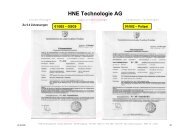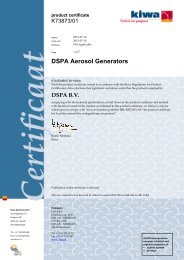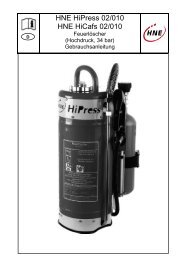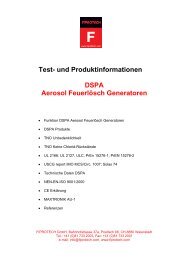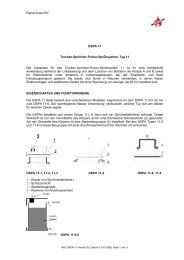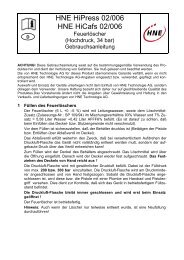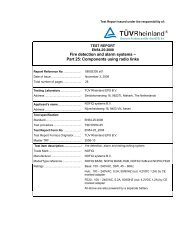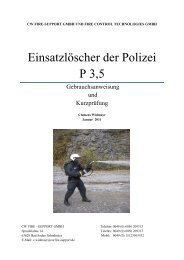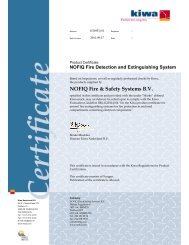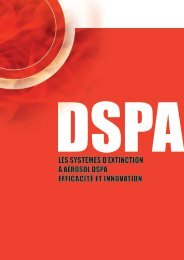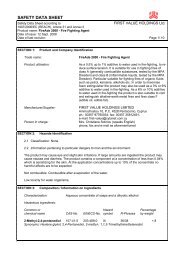FireAde 2000 Hydrocarbon suspension technology - Flame Guard
FireAde 2000 Hydrocarbon suspension technology - Flame Guard
FireAde 2000 Hydrocarbon suspension technology - Flame Guard
Create successful ePaper yourself
Turn your PDF publications into a flip-book with our unique Google optimized e-Paper software.
8<br />
®<br />
Smoke reduction when using <strong>FireAde</strong> <strong>2000</strong><br />
On 3) Interrupting the chain reaction<br />
of the free radicals<br />
Free radicals are uncharged molecular components<br />
with high reactivity. They collide with fuel sources in<br />
Class A or B at high speed. This causes heat and<br />
even more free radicals to be released, triggering a<br />
chain reaction which in turn accelerates the<br />
combustion process. Due to its high molecular mass,<br />
<strong>FireAde</strong> <strong>2000</strong> inhibits the radical chain reaction by<br />
The agent for all types of applications: <strong>FireAde</strong> <strong>2000</strong><br />
For the fire-fighting crew, good visibility has a major safety advantage, resulting in a lower risk to human life<br />
and property.<br />
The diagrams show that smoke development is significantly suppressed immediately after using <strong>FireAde</strong> <strong>2000</strong>,<br />
even more strongly in the case of flammable liquids than for Class A fires, where smoke development was<br />
reduced by almost half. In the case of petrol and diesel fires, the application of <strong>FireAde</strong> <strong>2000</strong> as a 3% additive<br />
almost entirely eliminated the reduction in visibility caused by smoke after about 30 seconds.<br />
<strong>FireAde</strong> <strong>2000</strong> not only accelerates the improvement in visibility but also combats the formation of toxic<br />
substances often found in dense smoke.<br />
100%<br />
80%<br />
60%<br />
40%<br />
20%<br />
0%<br />
Smoke reduction<br />
(Class A fire)<br />
94%<br />
52%<br />
before after<br />
Smoke reduction<br />
(Petrol and Diesel fire)<br />
99%<br />
100%<br />
80%<br />
60%<br />
40%<br />
20%<br />
absorbing the energy of the free radicals released<br />
during these collisions and channelling it into the<br />
water.<br />
As the energy of the combustion system decreases<br />
as a result of the absorption of the high energy<br />
from the free radicals, the fire is extinguished.<br />
When the free radicals collide, soot and smoke are<br />
formed. In fact, soot is the third purest form of<br />
carbon.<br />
Biochemical and chemical oxygen consumption (BOD and COD)<br />
Oxygen consumption is a<br />
standardised measure for determining<br />
the degree of contamination<br />
of water reserves, especially in the<br />
case of polluted waste water or<br />
industrial waste.<br />
Chemical oxygen consumption<br />
refers to the amount of oxygen,<br />
in particles per million (ppm),<br />
that can be measured during the<br />
oxidation of organic material in<br />
the waste water.<br />
<strong>FireAde</strong> <strong>2000</strong> is fully biologically<br />
degradable and the results shown<br />
in the diagram show that <strong>FireAde</strong><br />
<strong>2000</strong> is far less harmful to the<br />
environment than traditional foam.<br />
mg/l<br />
300<br />
250<br />
200<br />
150<br />
100<br />
50<br />
0<br />
COD<br />
BOD<br />
93<br />
0%<br />
297<br />
1%<br />
before after<br />
<strong>FireAde</strong> <strong>2000</strong><br />
in comparison<br />
to AFFF foam –<br />
the difference<br />
is obvious.<br />
3% AFFF foam 3% <strong>FireAde</strong> <strong>2000</strong><br />
1<br />
7




